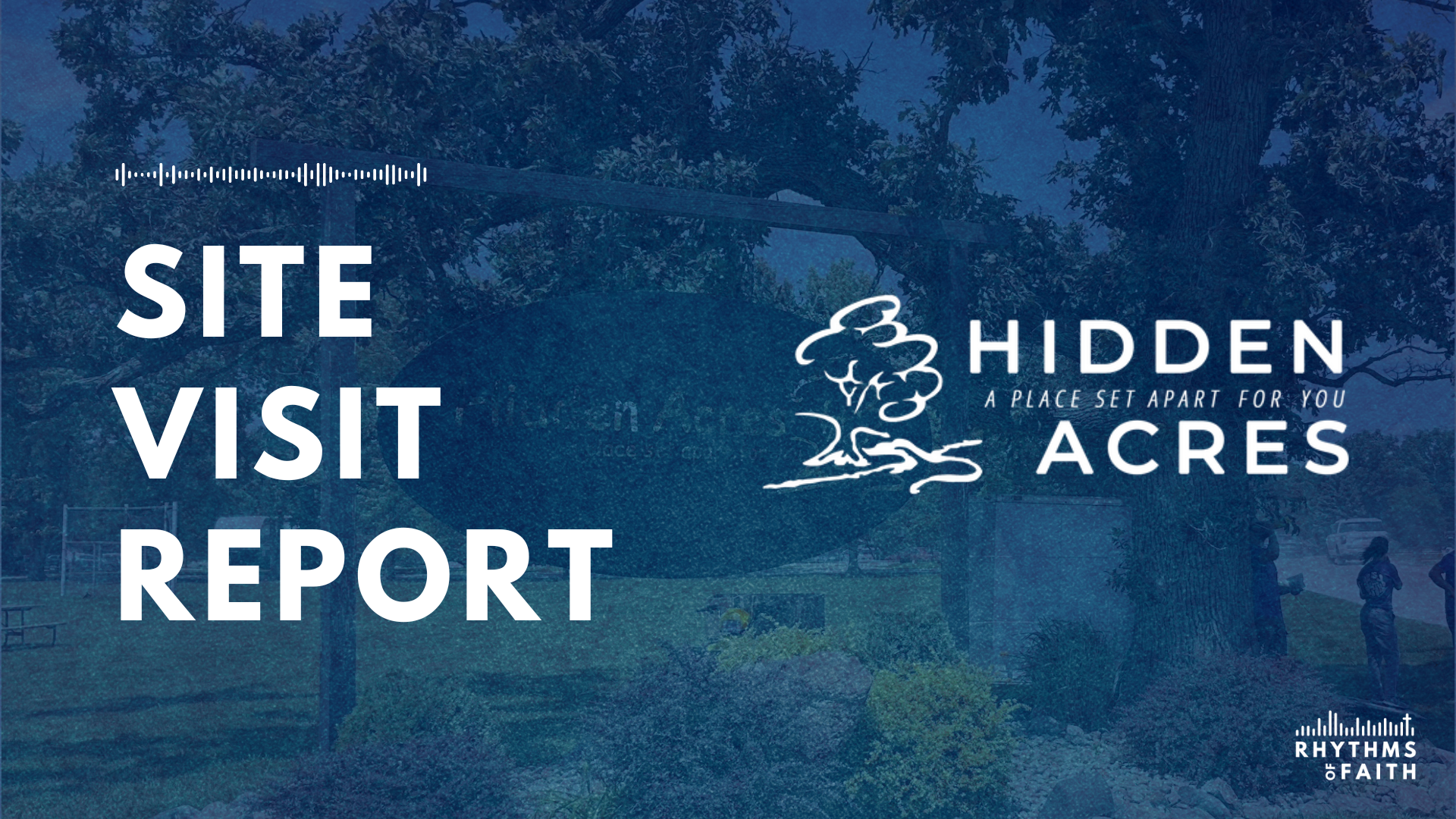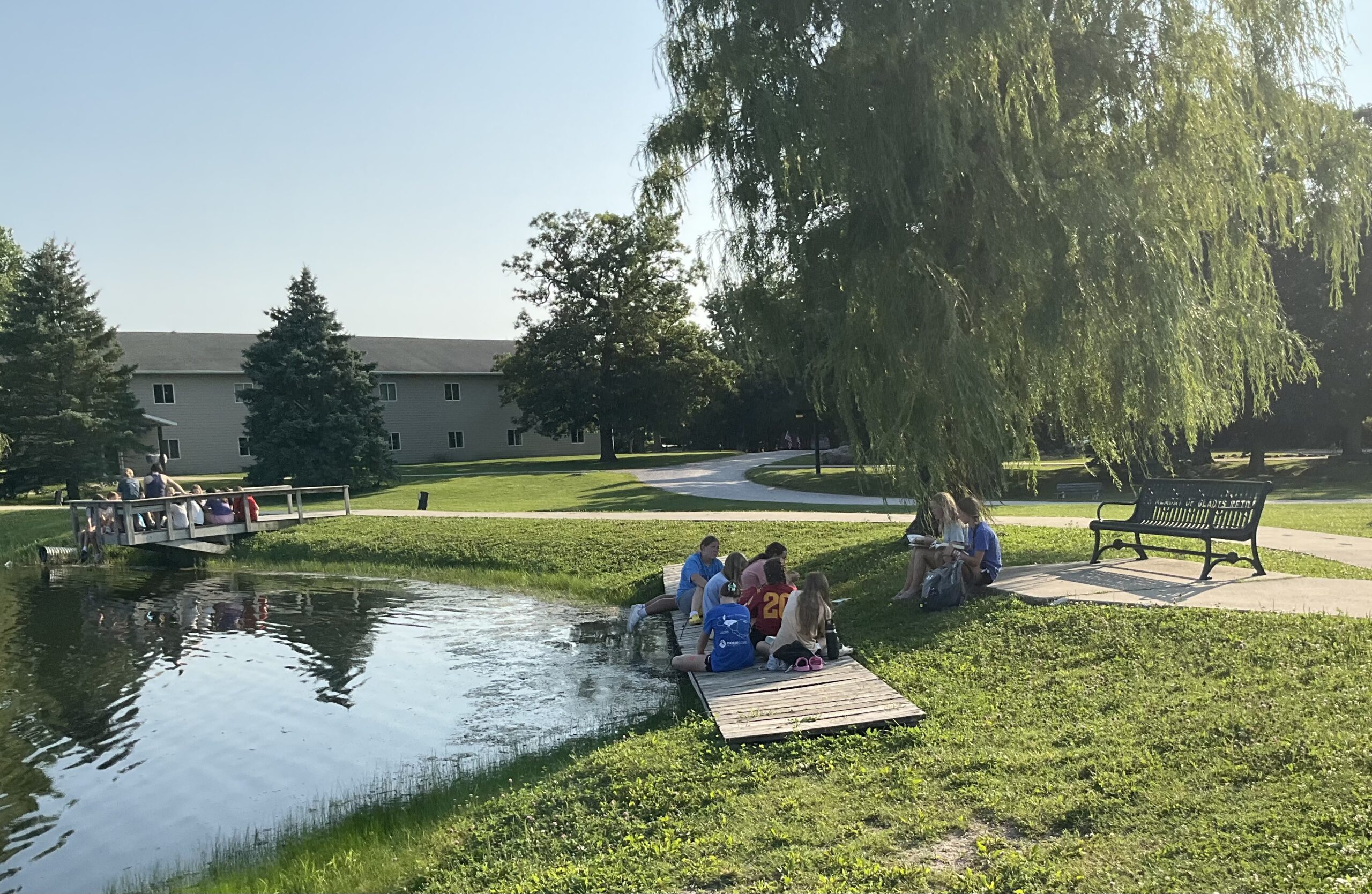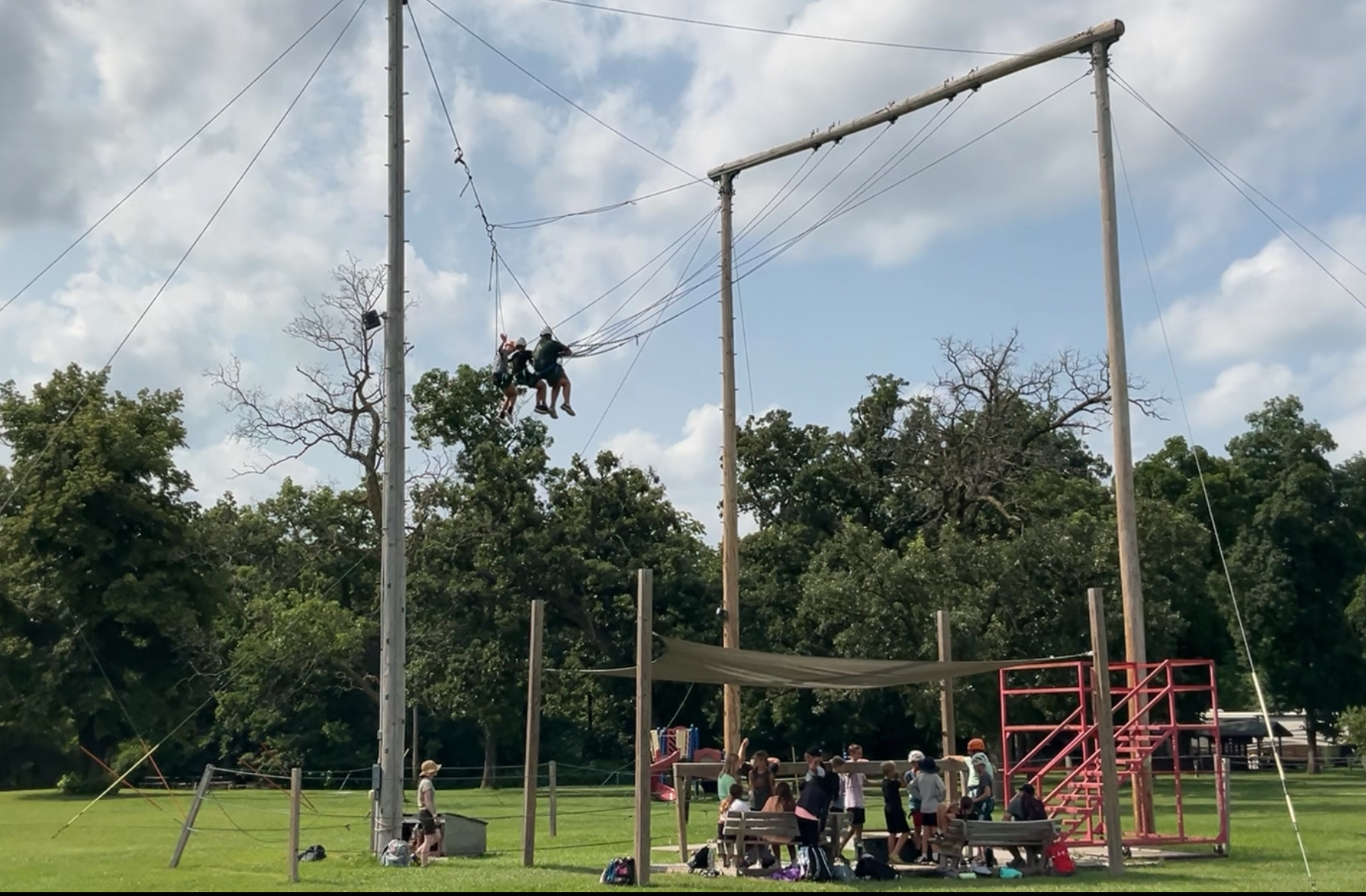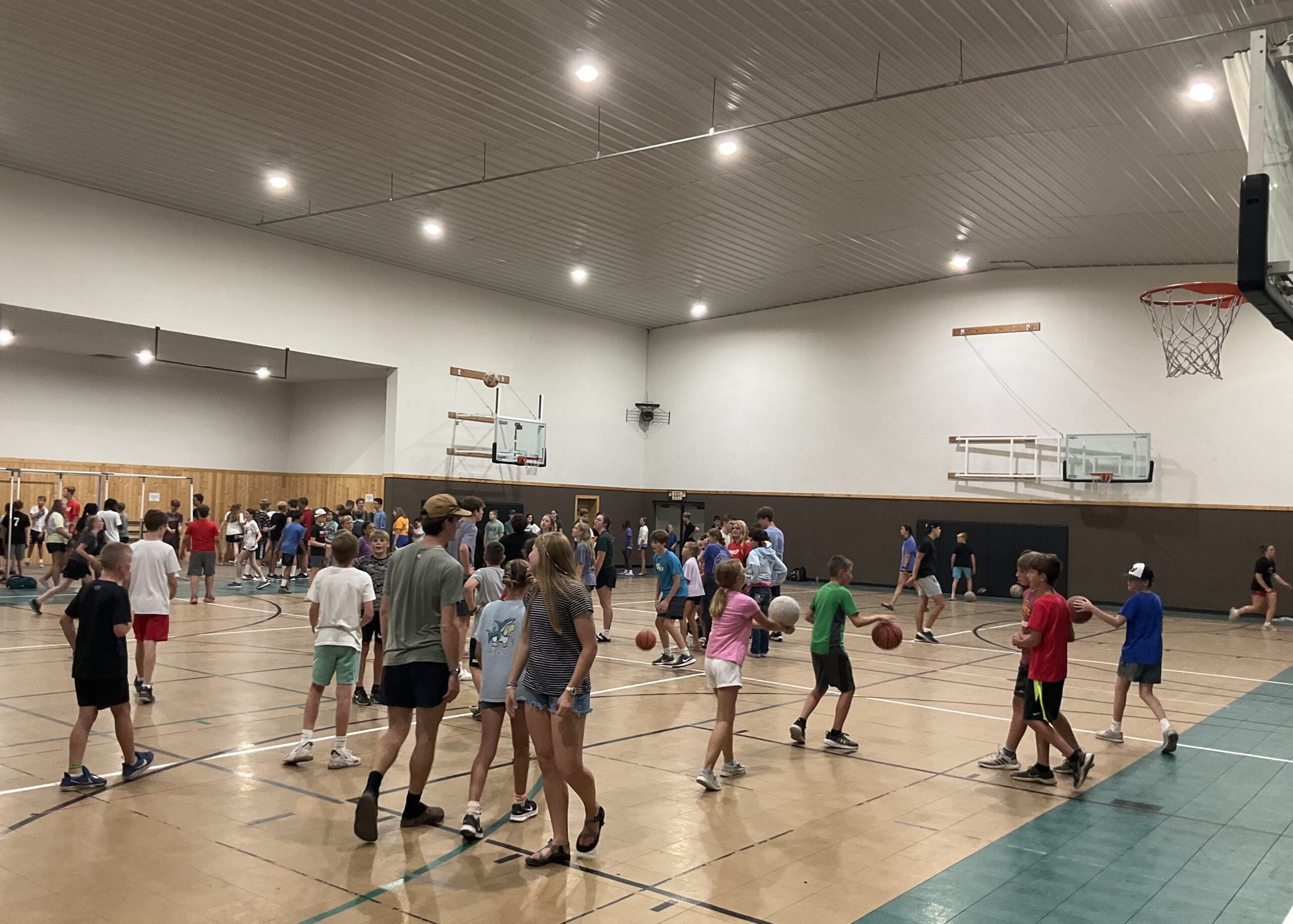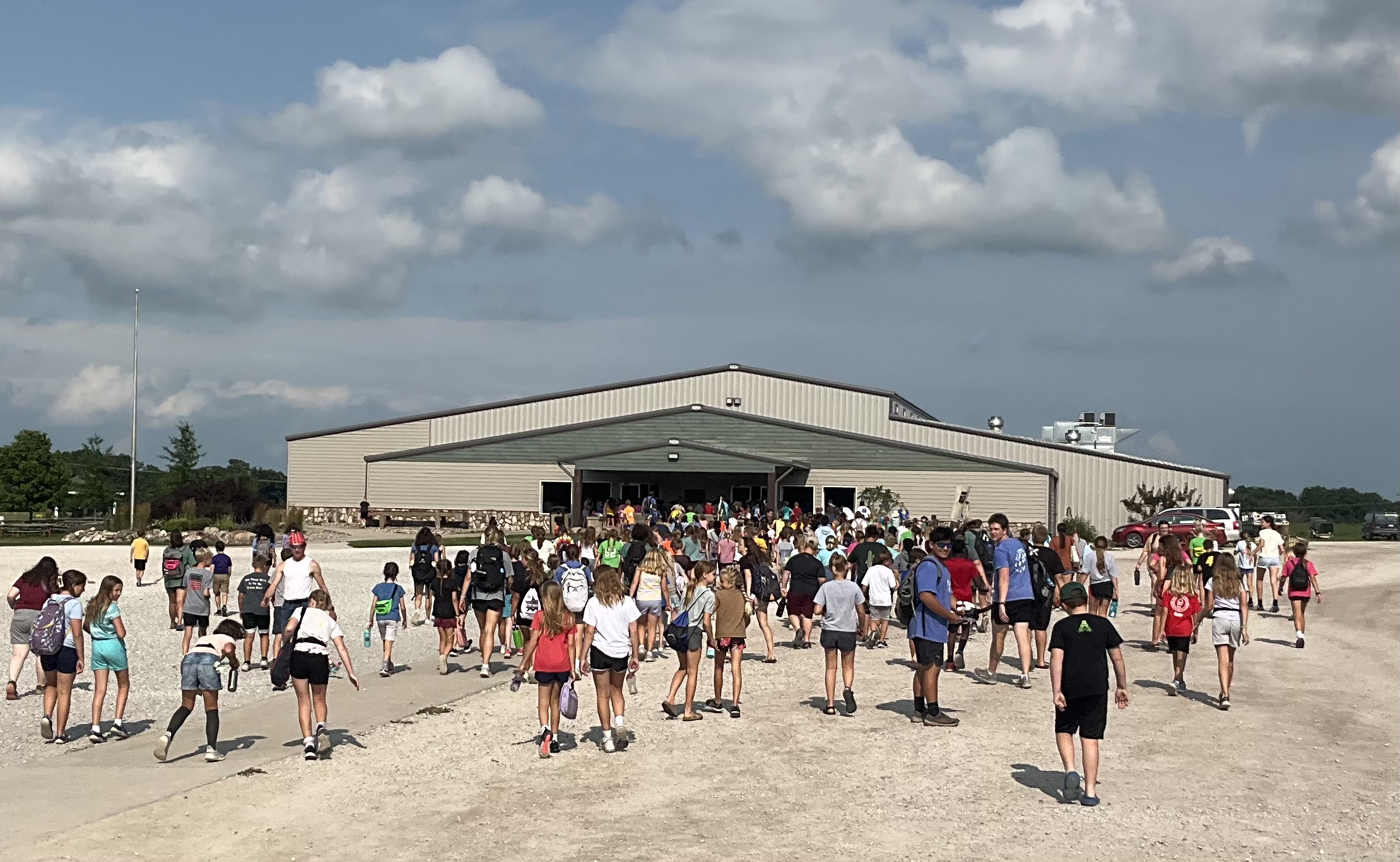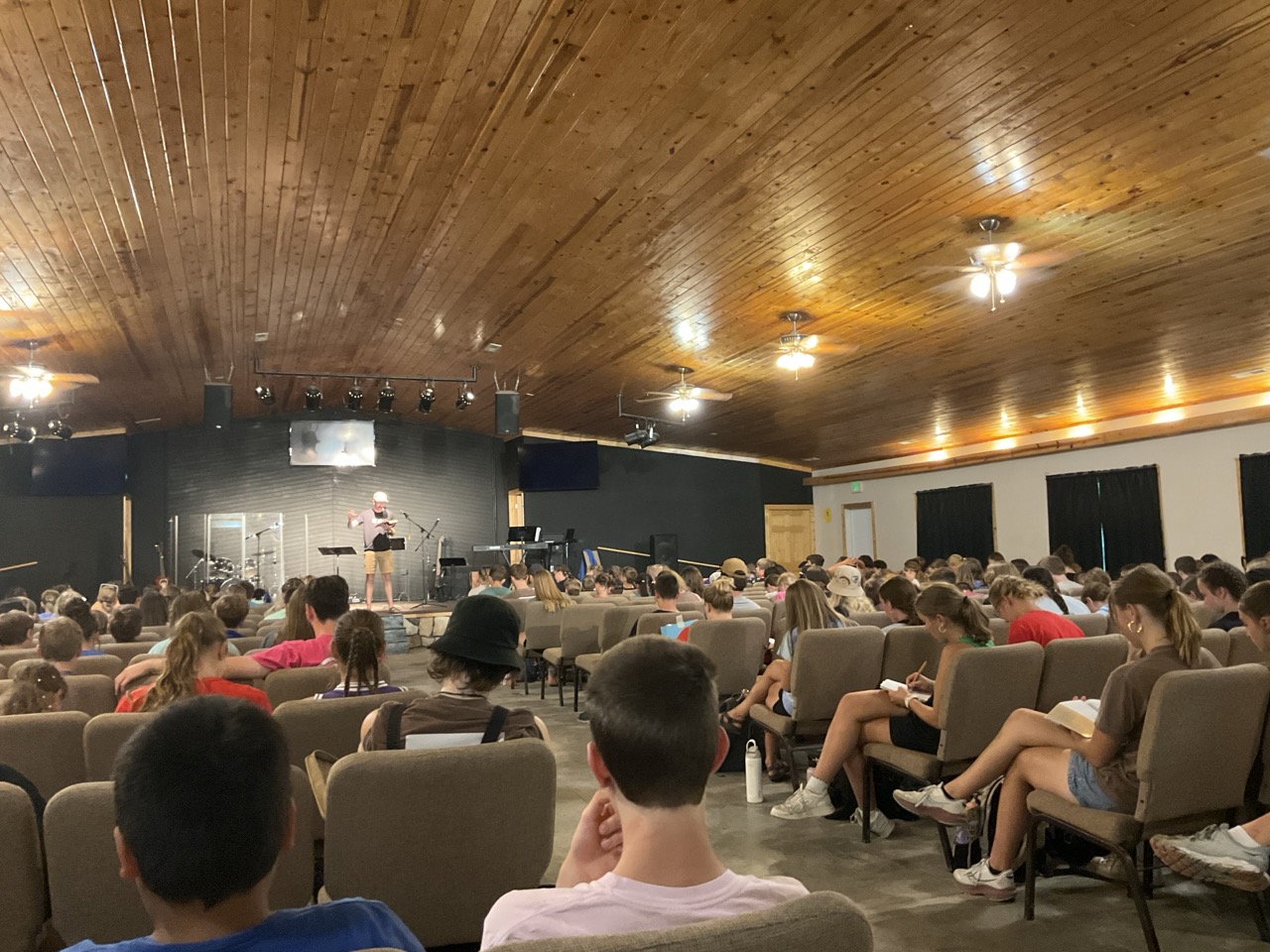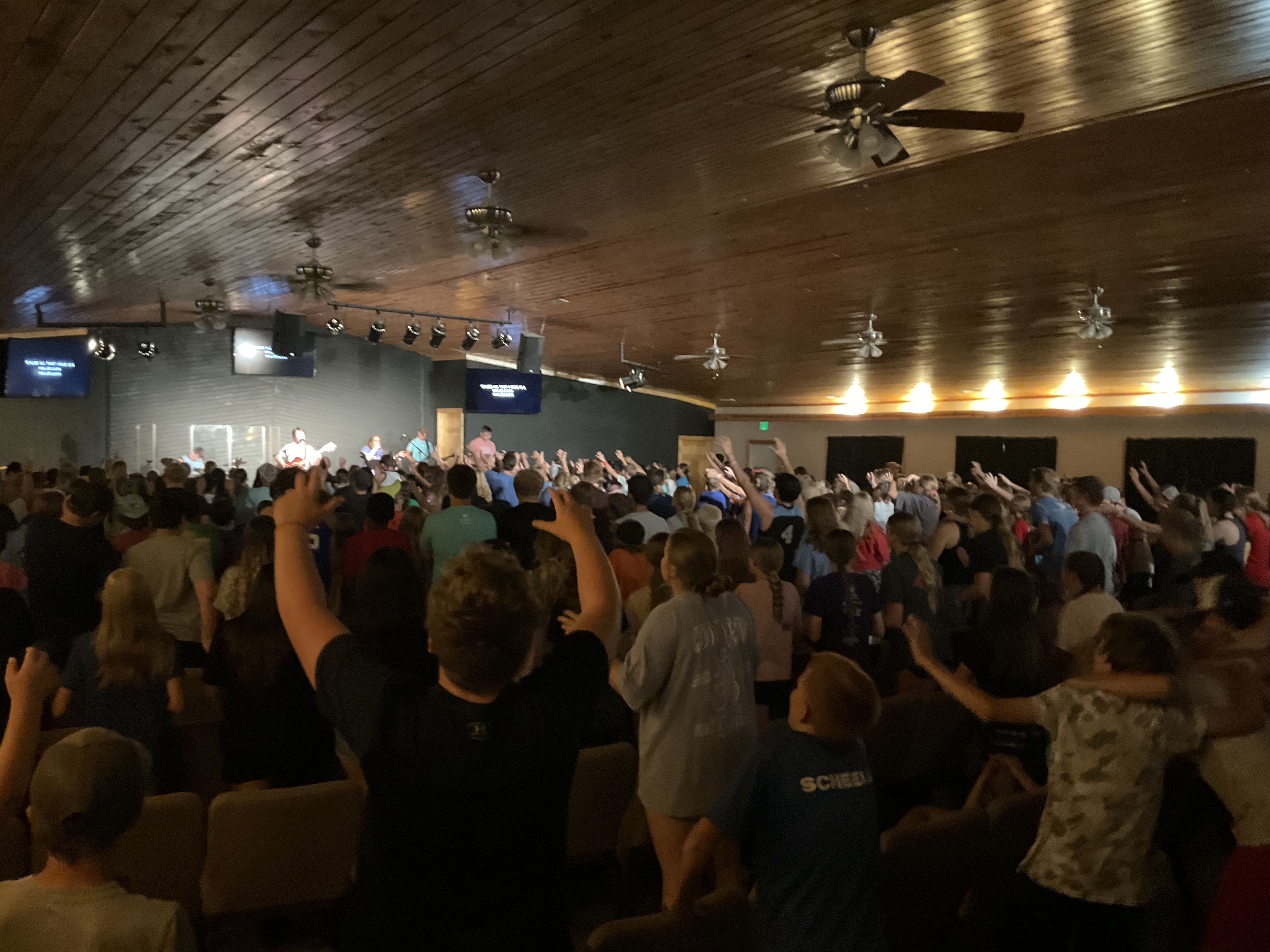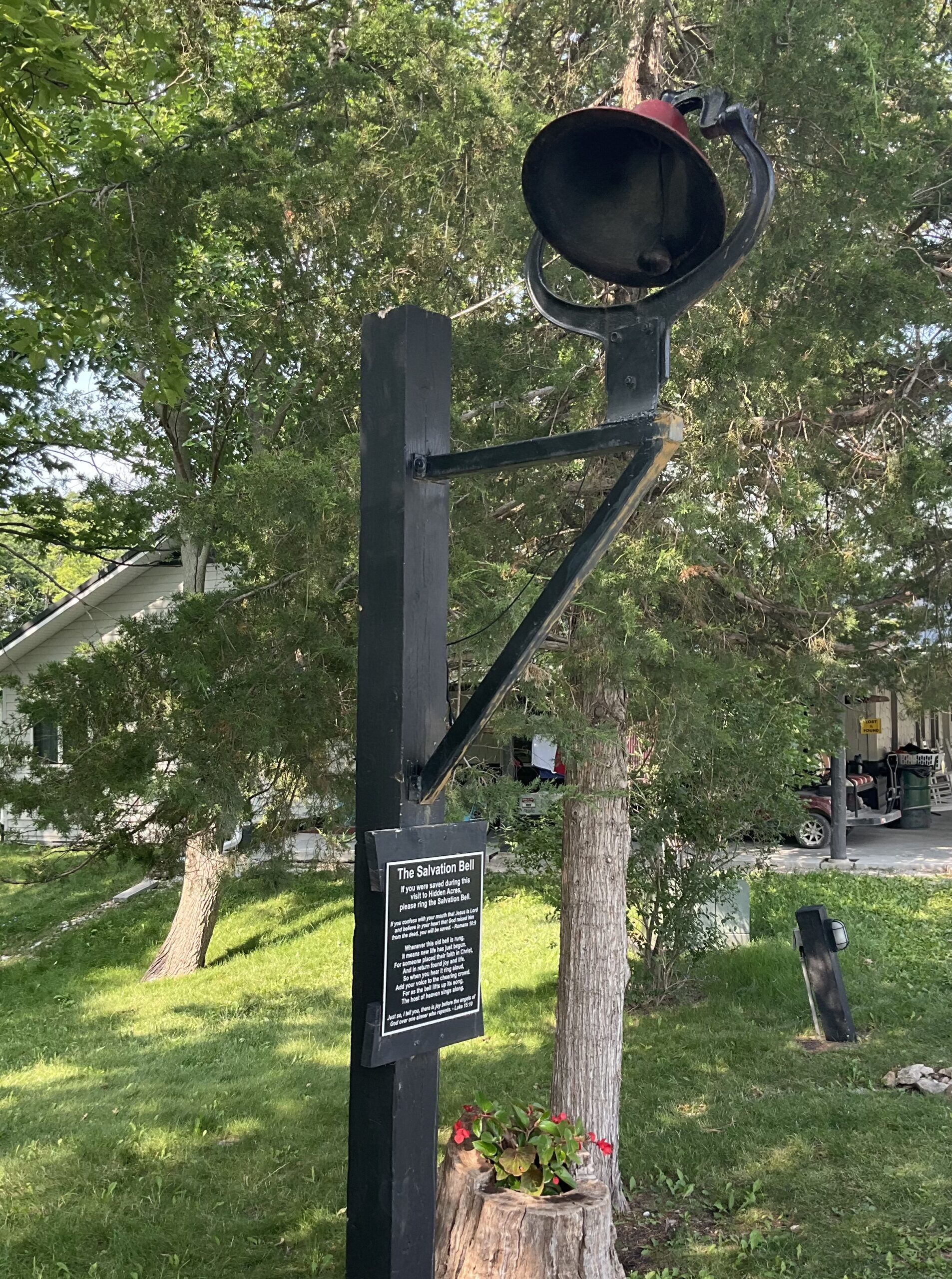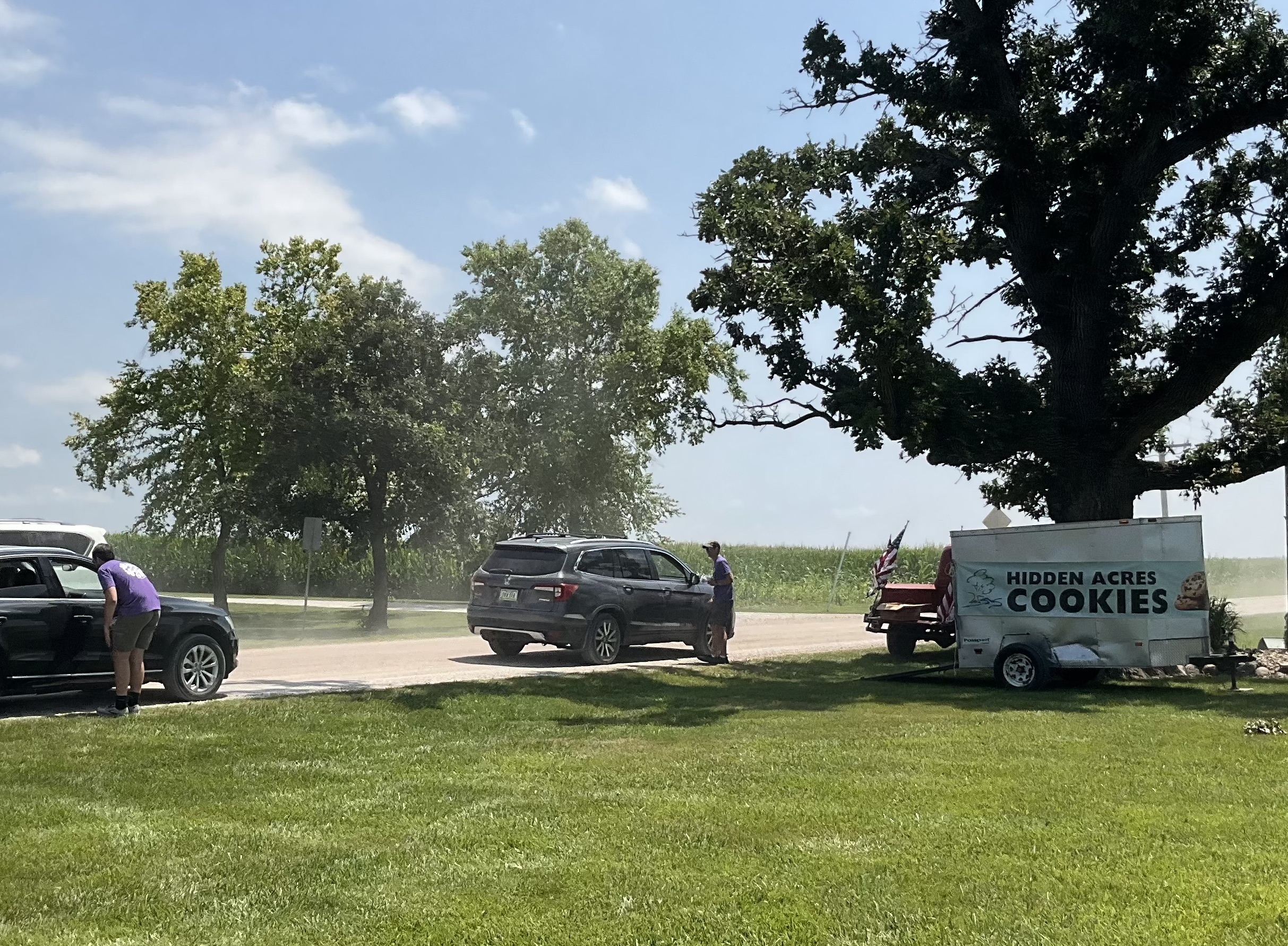Welcome to Hidden Acres
Surrounded by Iowa farm fields and buffeted by a preserve of beautiful hardwoods sits a bustling center of life, activity, laughter, and faith formation. Hidden Acres operates camp on a massive scale, yet they also remain committed to intimate, small group faith formation. At any given moment, you may find young people caught up in the cacophony of a large group game or engaged in deep discussion about how the Bible relates to their lives alongside a small group of peers and a trusted young adult mentor. The juxtaposition of large group and small group seems jarring at times, but campers, staff, parents, and church leaders remain committed to this place and are adamant about its impact on their lives.
Hidden Acres is the primary summer camp for the Central District of the Evangelical Free Church, which stretches across several states. The camp works to form a close partnership with local churches. As several camp leaders said during my visit, they seek to be “collaborators, not competitors.” Local church leaders describe the camp as a leadership training center for their young people, particularly the high school students serving on summer staff as junior counselors or the leadership and service program known as Timothy Team (or T3). The camp also offers curricular resources for church partners, regularly hosts church retreats year-round, and has begun offering traveling day camp for local churches during the summer months. When asked to join a focus group for this research project, local church leaders were eager to travel to this set apart place and talk about what it meant for their personal growth and for their ministries.
A Place Set Apart
I came to this camp in west-central Iowa on a site visit for the Rhythms of Faith Project, which is investigating camp’s role as a catalyst for family faith formation. As I rumbled along the gravel road toward the camp entrance, a dust cloud marked my passage, a bean field on my right and a cornfield on my left. It doesn’t get more Iowa than this, I thought. My destination was obvious, even without the signs directing me to Hidden Acres (“A Place Set Apart for You”). Jutting out of a landscape of farmland in every direction was an entire section of forest land comprising the 660 acres of Hidden Acres Christian Center.
Entering the property, a large but deserted game field stretched to my left, and an enormous gravel parking area on the right looked rather desolate, with half a dozen lonely vehicles in a space that could fit hundreds. The large dining hall at the far end of the parking lot was devoid of activity, since I had just missed lunch. There were allegedly more than 600 kids at camp this week, so where was everyone? Straight ahead was the welcome center, and here were the first signs of life and activity that I expected on a Wednesday afternoon of summer camp. Everyone began greeting me at once, and I was soon shaking hands with Taylor and Josh, the summer ministries managers who I had spoken with on the phone. We were soon touring the camp property on a golf cart, accompanied by a visiting church leader, who was one of two helping to lead chapel services this week.
We drove the gravel roads that wind and crisscross through the camp property, passing camper groups that were engaged in various afternoon activities. One group was setting out for a horse ride from the large stables. Several groups were in the high ropes area, climbing the tower, riding the zip line, and swinging from the 3-person giant’s swing. Down at the small lake, a group was splashing down an enormous, snaking water slide, which looked like it belonged at an amusement park. (Indeed, I learned that the slide had been relocated from a closed amusement park in Des Moines.) We came across an obstacle course, where a group of boys smiled and waved their airsoft guns at us (Airsoft Camp is one of their most popular programs).
But the real center of activity was the large Family Life Center (FLC), where hundreds of campers were engaged in a wide variety of indoor activities, such as billiards in the game room, basketball and volleyball in the large gymnasium, and the ever-popular 9-square in the air. This building also housed a bustling camp store full of camp merch, the “Snack Shack” (with a long line of campers waiting to buy treats), and an indoor swimming pool complete with lap lanes. There were smiling campers everywhere. It was all I could do to dodge or help field the incoming volleyballs, basketballs, and Frisbees that strayed my direction. Noticeably, the gaga ball pits stood empty. At Hidden Acres, campers prefer carpet ball. There were tables for this game peppered throughout the camp property, and campers seemed to fill every spare minute with a quick game.
A Hybrid of Small Group & Large Group Ministry
The place felt almost bursting at the seams. I was surprised to learn that they were actually committed to limiting the number of campers. In the years prior to the COVID-19 pandemic, Hidden Acres experienced rapid growth. Adopting a philosophy of serving as many kids as possible and turning no one away, they kept fees low and regularly overfilled camper groups. The pandemic forced them to limit the size of camper groups, and they quickly discovered that both staff and campers had a better experience when they stayed within their ideal ratio of one counselor for every six campers. Since the pandemic, they have remained committed to this ratio, and I could see the results in the quality small group interactions. Though the program was highly centralized and campers could easily get overlooked in the midst of large group activities, there was also a commitment to small group ministry that facilitated individual connection and intimate conversations. This helped to mitigate the feelings of getting lost in the shuffle or simply being a cog in a giant Christian assembly line.
Still, I got the sense that they were filling their buildings as quickly as they could build them. Many had a shiny new look, and one was just being completed, with the landscaping unfinished. This was the massive “Airnasium,” which could seat a thousand people before a large stage and had an initial look of an oversized pole shed, with its steel siding and ten large bay doors. But it could open those doors and transform into a huge open-air pavilion. The large new dining hall, built in 2017, also had a utilitarian look on the outside that belied a nicely arranged and wood paneled interior (though the concrete floors were clearly designed for quick cleanup). The sheer number of campers and staff there this week meant eating in two shifts, even in a facility that could accommodate nearly 1,000. The efficiency was breathtaking, and I have rarely experienced the equal in terms of food quality at summer camp (seriously, the Swedish meatballs were fantastic, but even they were edged out by the delicious fajitas the following night). The campers also raved about the food.
Campers stayed in a dizzying assortment of housing units, including traditional cabins with rows of bunks, a village of A-frame structures perched on the edge of a large hill, older retreat buildings with dormitory housing, and a lovely hotel-style building called The Inn, where I also stayed. Some buildings were temperature controlled, while others were not. There were campers in every nook and cranny, but the enormity of the property and generally centralized nature of the program meant that there were quiet, set-apart places around every bend in the trail, if you were willing to venture from the hub of activity in the center of camp.
The scale of the camp operations was truly impressive. This week had the highest enrollment of the summer, with 611 campers, alongside over 180 summer staff. There were two main age groups: Juniors (4-6 grade) and Junior High (7-8 grade), each comprising about half the camper population. These groups operated largely in parallel as two different camps, with separate mealtimes, chapel times, and large group game times. Each age group was in turn divided into 4 “quads,” and each quad was comprised of multiple cabin groups, which generally consisted of 12 campers and 2 counselors (one of these was a high school aged junior counselor). The cabin groups were the primary Bible study communities, which facilitated more intimate conversations and relationships in the midst of such a large camp community. The juxtaposition between the enormity of the camp operations and the intimacy of the small group was on display throughout my visit, sometimes in tension but also in complementarity.
The quads in each age group competed against one another in a series of all-camp games, which took place each evening. I was there for an epic version of capture the flag and a series of competitive water games collectively known as SUBOWW (Super Ultimate Bonkers Olympic Water Wars). The rivalry among the quads was one of the hottest topics of camper conversation, and the staff hyped these events each day. The winning quad gained nothing but bragging rights, but this was clearly motivation enough. There was consistent chatter about which quad was ahead in points and what place another quad needed to take that evening to overtake the lead. The dynamics of these all-camp games were interesting to observe and experience. While some campers were highly engaged and invested, others were less interested or simply opted out. The games generally had the feel of loosely contained chaos, which contrasted sharply with the carefully curated small group experience of the Bible studies.
Engaging the Bible
What really struck me programmatically was the emphasis on Bible study. There was a clear goal of engaging campers in deep and meaningful reflection on scripture, both individually and in small group conversations. Each full day of camp (Monday-Thursday), there were 3 blocks of time devoted to Bible study and conversation. Two of these were 1-hour blocks (morning and evening) for group devotions in their cabin group. The counselors led these discussions, using a detailed curriculum written especially for Hidden Acres. The other block of time (45 minutes) was reserved for individual devotions. The campers were equipped for this time with a personal devotional booklet that fit with the theme.
To equip the campers for personal Bible study beyond the camp experience, they taught a simple but unique method for personal devotions, cleverly using the acronym C.A.M.P. The letters stand for Choose a passage, Ask questions, Make it personal, and Pray. In the booklet, the passages were selected for the campers (all from the gospel of John this summer). However, they were encouraged to use the C.A.M.P. method on their own after camp was done. In order to emphasize this, they included a second week of devotions in the camper devotional booklet. Campers completed the first week of devotions during the programmed time at camp, and the booklet was designed to take home and help facilitate personal Bible reading after camp.
My conversations with campers indicated that these methods were effective. Campers who had been to camp in previous years reported engaging in personal Bible study with greater frequency after their camp experiences, and many indicated continuing this practice year-round. They also internalized the C.A.M.P. method for Bible study, able to identify the steps and describe what each of them meant in their own words.
This summer, the program staff introduced an additional innovation designed to promote family devotional practices. It was a small, printed family devotional guide with an aesthetic nearly identical to the camper booklet. It included a week’s worth of family devotionals and encouragement to continue the practice year-round. Taylor and Josh explained that they added the resource this summer after they heard the initial findings from the Rhythms of Faith Project. I spoke with a focus group of parents on the last day of camp, and they were excited about using this new resource. Alongside the adjustment they made to camper ratios in response to camper and staff feedback, this change is another example of the responsive nature of their leadership. They also gather feedback from summer staff each week of the summer and work to make improvements in real time, and they track camper experience through a simple end-of-week evaluation. This demonstrates an openness to change and commitment to improvement.
Directly resourcing families was a bit of a paradigm shift for camp leadership because they have largely viewed their role as supplemental to the local church. As Taylor put it, “The best way to help families is to connect them with a solid church that will disciple them and support them.”
Hearing God’s Voice
“Sing with us!”
The group of junior high boys had their arms around each other’s shoulders, swaying to the praise song. The shortest of them waved me over, as the others nodded in encouragement. We were in the large chapel with over 300 of our fellow siblings in Christ. I was honored by the invitation and moved in to join them. Arms around shoulders, we swayed and sang “Hallelujah” together. Afterwards, they all introduced themselves and thanked me for singing with them. The campers explained that these communities of fellow Christians set the experience apart from school and home. Campers I spoke with in focus groups said they felt “free” to talk about God and grow in their faith in ways that they didn’t in other places. One said, “All of the outside stuff stays way behind you, and you can focus on one thing, and that’s growing your faith.”
This was the second chapel service of the day. Morning chapel generally consisted of an introduction to the day’s Bible study theme, praise songs, and a testimony from one of the counseling staff. Evening chapel was a bit longer. It started with Chapel Fun Time, which was generally a silly game of some sort that was run game-show style. This was always a bit raucous and was clearly designed to get the campers excited. Evening chapels included a message from a visiting church leader, who was there all week. The messages focused on the scripture passages for the day and included deep exploration of the text. At each chapel service, the campers were encouraged to take out their Bibles and follow along. Most of them did so. Once again, I noticed the intense focus on the Bible and equipping the campers for Bible study away from camp.
I also noticed the emphasis on church engagement. The counselors and visiting leaders consistently encouraged the campers to engage in Christian community away from camp. The chapel building was arranged like a church, and the worship style was familiar for all those coming from the Evangelical Free tradition, including popular praise songs and a minister offering reflections on a scripture passage. The theology was also familiar, with a strong emphasis on substitutionary atonement and personal salvation through accepting Jesus.
They intentionally avoided large group altar calls, deferring instead to the small, trusted cabin groups for those who wanted to have a discussion about making a faith commitment. The summer staff confirmed to me that they worked to avoid pressuring the campers to give their lives to Christ, focusing instead on teaching discipleship practices and encouraging connection to the local church. They indicated that they did not want campers to feel like Christ was uniquely present at camp or that their faith was only meaningful at camp. As one put it, “It’s not that God speaks louder at camp. It’s that the world is quieter.”
But then the bell would toll. This was the “Salvation Bell,” located in the center of camp. Each time a camper made a first-time commitment to Christ, someone would ring the bell, with responding cheers from those nearby. Every chapel service I attended included explicit encouragement for campers to accept Jesus and to talk to their counselors about giving their lives to Christ. The philosophy of not pressuring campers existed alongside the bell in an interesting dichotomy. I reflected that this was not unlike the sometimes-messy hybrid of small group intimacy and centralized activities.
Go with God…and Cookies
“He received the sincerity award this week because of the way he interacted with his fellow campers.”
The parents smiled and looked fondly at their son, as they received the printed Sincerity award from their child’s counselor, along with a cabin picture. I watched as parents arrived to pick up their children and had these brief but meaningful interactions with the counselors. Each child received a personalized award corresponding to a spiritual gift that the counselors recognized in them. In my focus group with parents, some said that their children cherished these recognitions throughout the year, posting them in prominent places in their bedrooms. The parents indicated greatly enjoying this tradition.
After loading up their vehicle, parents and caregivers rumbled down the gravel road toward the camp exit. There, the camp’s executive director or other full-time staff waited for them next to a large sign reading, “Hidden Acres Cookies.” I had heard about the cookies. Actually, I had eaten quite a few in my days at camp. As good as I found the food in the dining hall, I learned that Hidden Acres is most known for their cookies. They take them on church visits and when they are out recruiting summer staff. They go through thousands of them. As families leave camp, the last thing they get is a personal greeting from the full-time camp staff, along with a cookie for everyone in the vehicle. But that is not all. This year, they also receive the family devotional to help them continue their journey of discipleship together in the weeks and months to come.

